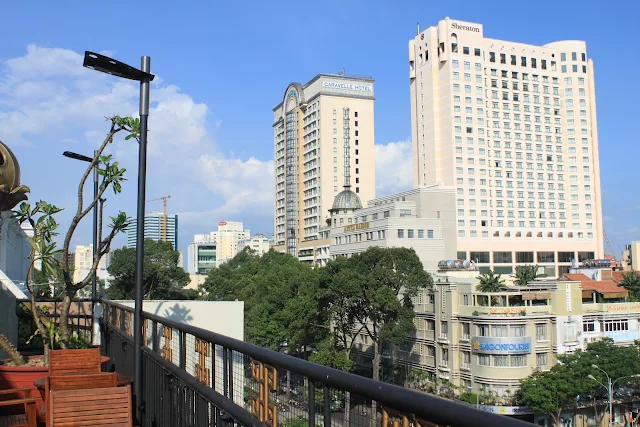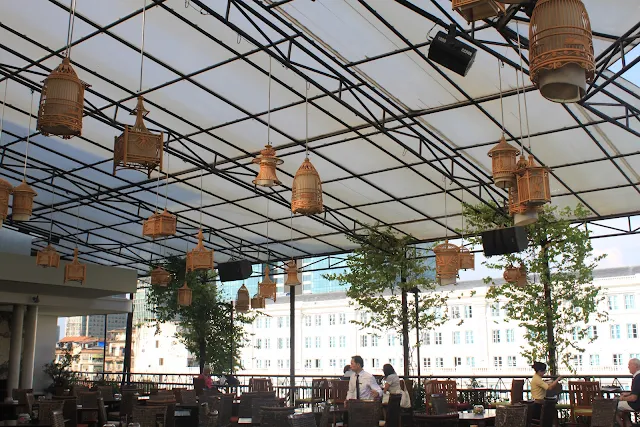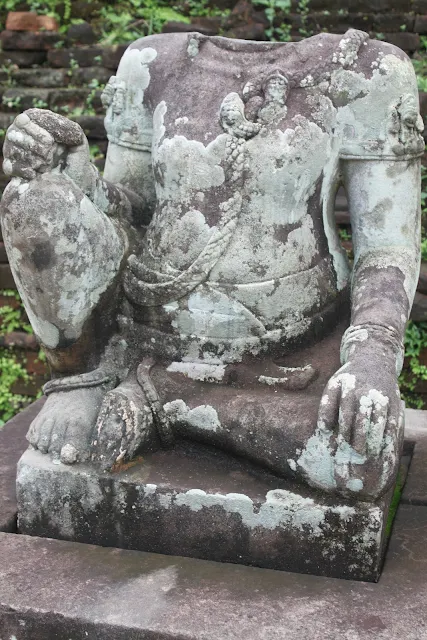Kindly Yours - A collection of writings, thoughts and images. This blog does contain third party weblinks. No AI content is used.
Thursday, 29 November 2012
Nha Trang, Vietnam - Transitions
National Geographic has condemned Nha Trang beaches in 2010 as suffering "over development without a watchful eye". I could sense some of this as my fellow travellers and I walked along the main beach area (the Tran Phu coast), noticing continuing construction of major hotels along an otherwise clean and soft sand stretch with outer isles visible on the horizon. The Tutukaka Coast of Northland in New Zealand, the northern coast of Mozambique, Broome in Western Australia and the southern coast of Sri Lanka were rated highly by Nat Geo in that survey (99 Top Coastal Destinations on http://travel.nationalgeographic.com/travel/coastal-destinations-rated/
Above picture shows a view from the KFC joint in the tourist hub in Nha Trang, especially favoured by Russian visitors of all ages as the city has direct flight connections with Russia. Not far from this corner is the Sailing Club.
A bird's eye view of Nha Trang city from a look out point (picture above) contrasts with the main city beach in the early morning mid-week (photo below). The city has lively markets in the evenings, a growing population drawing immigration from other parts of Vietnam and is foreseen to have significant changes in the coming years - I am reminded of Phuket and Pattaya in Thailand in their hectic tourist affected years in the seventies and eighties. How this late comer to the competitive beach scene navigates through the economic, commercial and political temptations, opportunities and dangers of being an international beach destination, is worth watching. There is an interesting local life away from the tourist areas and how the benefits and risks of tourism affect them is in the end the most important thing, apart form the tourist dollars. Nha Trang was the site of the Miss Universe competition in 2008.
A placid moment with only few vehicles in front of the official government building of culture (above). The municipal area continues to expand with housing and commercial development across what was once naturally kept plains towards the mountains (below). Both the French colonists and American marines loved this place fortunate enough to have an impressive bay - which Travel & Leisure magazine included as part of the top 29 beautiful bays in the world. Its site harks back to the Champa Kingdom more than a thousand years ago - you can view the rather intact Po Nagar Towers north of Nha Trang central. It is now a significant scuba diving, kite boarding, birds nest collection and lobster farming centre for Vietnam, although do avoid the monsoon season from mid-October to December.
Art deco (above) can be encountered along the main strip at Nha Trang's city beach. Below, a view from the top floor of our hotel looking out at a main tourist street replete with scuba diving shops, local food and fruit outlets, tourist orientated cafes and restaurants, retail shops offering day excursions and visitor accommodation. There is a heightened risk of security and creepiness late at night in Nha Trang, although when we were there it approached Halloween night, with many street and restaurant parties not just involving visitors but the locals.
My group had the chance to spend a day at a beach an hour by van out of Nha Trang and we already noticed more beach hotels being built or planned as we went along the highways away from the city itself.
We had a local themed lunch like a picnic, with tasty grilled meats on skewers, lots of cut fruits and salads plus cold beer and drinks. Life looks more pleasurable and simpler lying on a deck chair on a remote beach in Vietnam.
Wednesday, 28 November 2012
Nha Trang, Vietnam - Halloween Dinner
The Sheraton at Nha Trang in south-eastern Vietnam set the scene for a celebratory buffet dinner on its first floor. Staff wore Halloween themed masks, table settings had pumpkin covers for dining lights and even the napkins followed the tone in black and white. The cook staff behind various corners and cooking displays were international. Some items were meant for cooking according to your preferences, others were ready to be consumed and the choices were more than ample.
I was more than happy with my choice of freshly prepared gnocchi served in a fabulous tomato-based sauce (photo above). My other favourite was the sushi and sashimi (picture below) - delicate, precise and subtle in flavours. Service was delightful from smiling and well trained staff.
Dragon fruit slices (bottom right in photo below) were part of chocolate fondue skewers. I am fond of the bananas in Vietnam - petite, tasty and wholesome. Papayas, honeydew and strawberries contributed to an interesting platter to wind up the dinner. Below on the main strip facing Nha Trang city beach, looking through the large glass windows, we could see people still milling on the pavements, as night transformed parts of otherwise empty spaces in the day time to markets with many stalls after sunset. The commercial penchant for activity is truly alive in Vietnam, whether amongst the locals or for tourist interaction.
Monday, 26 November 2012
Saigon Symphony
The early evening view from the top of the Rex Hotel (above), looking out across the main road to the revamped Hotel Caravelle. The Rex Hotel was famously the site where American soldiers provided skewed press briefings around five o'clock each day and today it continues to thrive along the Nguyen Hue Boulevard in the city centre as both a lively day and night gathering spot. The Caravelle Hotel, across the road at Lam Son Square, served its own distinction to attract hordes of diplomats and journalists during the sixties and early seventies - and when opened in 1959 at ten stories high, was the tallest building in this bustling metropolis. Both the New Zealand and Australian Governments once maintained embassies here.
It is worth a visit to the renovated marbled roof top bar.
The colours are bright pink and do not fail to catch the eye of the passer by in District 3 - with arched windows and doorways, plus immaculate grilled iron work, this Catholic Cathedral has tall spires and side alcoves that are based on French architectural traditions. This is the second largest church, after the city's well known Notre Dame Cathedral - the Tan Dinh Church ( or Church of the Sacred Heart of Jesus). Saigon has several religious buildings of note, and they include the Cao Dai Holy See, the Quan Am Pagoda, the Jade Emperor Pagoda and the Mariamman Hindu temple.
When I reflect of grassroots Saigon, I recall this roadside scene with fondness - electric cables that grotesquely meet and almagate, peddlers in traditional coned hats , motor cyclists, modern city buses, side stores and people going about their commercial lives - in front of a large market venue.
One can sip filtered Vietnamese coffee anywhere - on roadside pavements, in heritage coffee shops, from a village stall, in a tourist hub or in a modern cafe based on franchised lay outs and in air-conditioned comfort - above picture was taken at a Trang Nguyen outlet in Saigon along the Hai Ba Trung in District 1. No paper filters are utilised in the making of the cafe sua da - drip coffee that requires no massive cleaning effort afterwards or use of large machines. Vietnamese coffee is infused with chicory, a caffeine free herb and dark roasted blends are always used.
Bamboo and rattan bird cages hang from a high ceiling (picture above) in front of heritage buildings whilst below, a snapshot in a room at the Novotel Saigon Centre, which opened only this year. The affinity with bird cages is well documented and known in south-east Asia and China - they are used to keep song birds in courtyards, gardens and outside houses and shops. Such birds are taken by their owners to accompany them for meals with friends and family. Interesting enough, such bird cages are increasingly utilised as lamp holders or as mere decorations to bring up the vitality of an otherwise empty space or high ceiling, especially in heritage hotels.
Saturday, 24 November 2012
My Son, Central Vietnam
The grandeur and extent of Hindu based empires in south-east Asia from long ago may be understated in the current make up of the countries that make up ASEAN today. Echoes and suggestions of this significant past influence can only be reminded to us when we visit Bagan in Burma, Ayuthaya in Thailand, Borobudur in Java and the Angkor Wat in Kampuchea. My early history school books did mention about the Champa Kingdom that extended from the 4th to the 14th centuries AD throughout most of what is referred to as IndoChina in contemporary times. So with eagerness, I relished the opportunity to explore the collection of sizable ruins and remains of tower temples at My Son in Central Vietnam (south-west of Da Nang). Sanskrit and Cham languages were heavily used in this hub of religious and political practice, with around seventy structures existing at the height of the power of the Champa Kingdom. "My Son" in the Vietnamese language simply means "beautiful mountain".
My Son is primarily dedicated to the devotion to the Hindu deity Shiva, under the form of the Linga and under the name Bhadresvara. King Bhadravarman who ruled from 380 to 430 AD had a special plea to his successors "Out of compassion for me don't destroy my gifts." It is with sad irony that the ruins were further damaged by American B52 fighter planes when engaging militarily with the Vietcong in the sixties last century. The area also witnessed significant intrusions from the Chinese from up north, notably by General Liu Fang in 605 AD, and to military encounters with the Viet. Most of the standing buildings today originate from around the tenth century AD. Rediscovered by a Frenchman, M.C. Paris in 1898, the site had been reclaimed by the tropical jungles after the advent of the Viet - and the Chams themselves had transformed to a different culture and some of whom are Muslims today. My Son's restoration is mostly supported by the governments of Italy and Japan.
Key icons of the Champa Kingdom include the elephants (photo of their motifs above) and a rich cultural heritage, as exemplified by the show put on for modern day tourists (picture below).
My Son also offers a much appreciated walk in the forest, away from the high density regions in Vietnam, away from the hordes of fast moving motor bikes on city roads and engaging with the atmosphere more akin to the Central Highlands of Vietnam. A gateway (below picture) is only one of varied features of architecture you can examine and feel - there are causeways, long passages, shrine halls, gate towers, fire houses and more. A kalan is a bricked sanctuary used typically to house a deity.
Remains of altars in both pictures above and below are only a shade of what it must have looked like centuries ago. There is an internal gallery at D2, which offers in one spot a collection of the main artifacts.
The buildings that remain in My Son were made of red brick, with only one designated as B1 constructed from stone. An intriguing question is how were the bricks were held together, as no mortar can be evidently seen as not utilised (photo above). Important messages were inscribed on steles and they often relate to commemorations of gifts made to God, whether they are foundations made for altars, pedestals or temples, or community acts such as gifts of treasures or land. .
There is also a Museum of Cham Sculpture in nearby Da Nang, but nothing beats strolling amongst the ruins on a quiet and early Saturday morning, when colourful butterflies seem to float around and above the surrounding foliage - and when visitors can imagine the vibes of another time, another place in history. The then ruling Dua Clan ensured almost ten centuries of continuous development and maintenance. A footnote - there are comparable buildings in Nha Trang, but much more well preserved, further south along the coast in Vietnam.- the Po Nagar Cham Towers. One will not easily forget the boat shaped roofs and carved pilasters of My Son.
Wednesday, 21 November 2012
Vietnam - Food Delights
Grilled corn cobs outside the Cu Ci Tunnels not far from Saigon.
The pho, unique from Vietnam, for the soup concoction, graced with rice noodles, aromatic herbs and chili cuts.
Breakfast tasty - egg omelette laden with ingredients of your choice and can include mushrooms, sausage bits, shallots and more.
Grilled meats, satay or skewer styled, here shown above held with wooden utensils, served at the Restaurant 96 in Ha Noi's bustling Old Quarter on a Wednesday evening in early November 2012.
A bird's eye view of street food in Hoi An, central Vietnam - sauces, greens and wraps accompany the ubiquitous grilled meat sticks.
The best Hainan-styled deep fried spring rolls as discovered at the Green Chili Restaurant in Hoi An's Old Quarter. The owner spoke to us on his careful and dedicated approach to ensure a really crispy batter outside with a fulfilling tasty bite inside.
Above picture captures two women busily holding court in a road corner stall in Hue selling the favourite pho noodles. We sat on really low plastic chairs and downed our piping hot noodles with a yogurt also provided by these ladies.
Vegetarian delights provided by monks at a monastery in Hue (photo above) and a delightful outcome of a fruit and vegetable carving demonstration aboard a cruise ship at Ha Long Bay (photo below).
The omelette, right in picture above, wrapped fillings in a traditional Vietnamese snack - taken in Hue.
Star View Restaurant, Georgetown - Penang
Duck slices served in a crusty edible cup holder, above, was an unusual creation I came across at the Star View Chinese Restaurant in the middle of Georgetown CBD not far from Burmah Road and next to the food court at the New World Park. Petite and tasty, it served as an attractive bite-sized idea. The Star View has been building up a reputation in Cantonese inspired dishes on the island of Penang and the challenge is to maintain the energy and reputation for discerning diners. Mum and family members recently had lunch there on a quiet Saturday afternoon.
We chose traditional favourites like marinated pork ribs, looking red as they should be. What caught my eye initially was the so-called dry version of the stir fry broad rice noodles (hor fun in Cantonese). I must say it tasted to me like fried char koay teow and yet it did not rise to the oomph of Penang's top hawker stir fry. Maybe I was too entrenched in the delights of the hor fun with a gravy laced with gooey egg and smooth texture. The Beijing duck came served with northern Chinese styled buns (the man tou) - picture below.
The prawns (photo above) with the dessert of tong sui (body nurturing ingredients like longans and gingko in a mild sweet soup (photo below) wrapped up the course meal. The lunch was not overbearing and moderate in pace. I enjoyed the quiet pace in the restaurant, sans the noise,crowds and clutter that can characterise most Chinese restaurants around the world
Subscribe to:
Comments (Atom)
Apparently Weird
The Seemingly Weird Things I Observe Individuals with agitated facial expressions talking loud to themselves in public - as they cleverly ...
-
Think of tangine, hummus and tabouli. I was first introduced to Middle Eastern food by a mate Fred in Canberra – Fred has a rich French an...
-
In 2025, Canada, except for her province of Saskatchewan, started Daylight Savings Time (DST) on 2 March. Nearby Nuuk ( Greenland, part o...
-
There are things I should have started long ago to clear up. I am good at putting in one place unfinished tasks. Written lists of quest...




















































